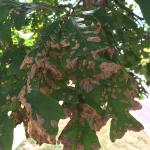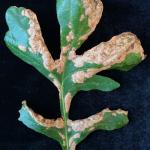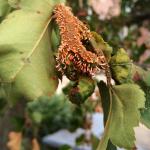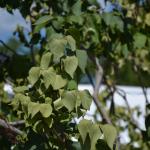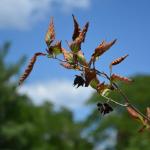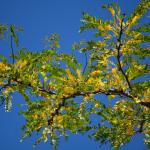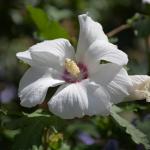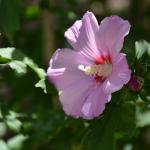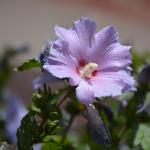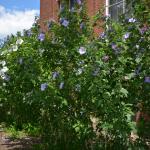UMass Extension's Landscape Message is an educational newsletter intended to inform and guide Massachusetts Green Industry professionals in the management of our collective landscape. Detailed reports from scouts and Extension specialists on growing conditions, pest activity, and cultural practices for the management of woody ornamentals, trees, and turf are regular features. The following issue has been updated to provide timely management information and the latest regional news and environmental data.
The Landscape Message will be updated bi-weekly July through September. The next message will be available on August 12. To receive immediate notification when the next Landscape Message update is posted, be sure to join our e-mail list.
NEW! To read individual sections of the message, click on the section headings below to expand the content:
Scouting Information by Region
Environmental Data
The following growing-degree-day (GDD) and precipitation data was collected for an approximately two week period, July 14 through July 27. Soil temperatures and phenological indicators were observed on or about July 27. Total accumulated growing degree days (GDD) represent the heating units above a 50° F baseline temperature collected via our instruments for the 2016 calendar year. This information is intended for use as a guide for monitoring the developmental stages of pests in your location and planning management strategies accordingly.
|
Region/Location |
GDD |
Soil Temp |
Precipitation |
Time/Date of Readings |
||
|
2-Week Gain |
2016 Total |
Sun |
Shade |
|||
|
Cape Cod |
334 |
1388 |
83 |
73 |
0.17 |
3:10 PM 7/27 |
|
Southeast |
337 |
1340 |
84 |
75 |
0.92 |
5:36 PM 7/27 |
|
North Shore |
364 |
1367 |
71 |
67 |
0.19 |
10:30 AM 7/27 |
|
East |
398 |
1551 |
80 |
73 |
0.38 |
5:00 PM 7/27 |
|
Metro West |
363 |
1445 |
72 |
68 |
0.41 |
5:45 AM 7/27 |
|
Central |
369 |
1518 |
73 |
71 |
0.02 |
4:42 PM 7/27 |
|
Pioneer Valley |
362 |
1539 |
77 |
74 |
0.88 |
10:30 AM 7/27 |
|
Berkshires |
344 |
1346 |
73 |
67 |
0.29 |
9:00 AM 7/27 |
|
AVERAGE |
359 |
1437 |
77 |
71 |
0.41 |
- |
|
n/a = information not available |
||||||
Phenology
Phenological indicators are a visual tool for correlating plant development with pest development. The following are indicator plants and the stages of bloom observed for this period:
| Indicator Plants - Stages of Flowering (BEGIN, BEGIN/FULL, FULL, FULL/END, END) | ||||||||
|---|---|---|---|---|---|---|---|---|
| PLANT NAME (Botanic/ Common) | CAPE | S.E. | N.S. | EAST | METRO W. | CENT. | P.V. | BERK. |
| Clethra alnifolia (Summersweet Clethra) | Begin | Begin | * | Begin | Begin | Begin/Full | Begin | * |
| Hibiscus syriacus (Rose-of-Sharon) | Begin | Full | Full | Full | Begin/Full | Full | Full | Begin |
| Buddleia davidii (Butterfly Bush) | Begin | Full | Full | Full | Full | Full | Full | Begin |
| Campsis radicans (Trumpet Vine) | Full | Full | Full | Full | Full | * | Full | Full |
| Oxydendrum arboreum (Sourwood) | Full | Full | Full | Full/End | Full/End | Full | Full | * |
| Koelreuteria paniculata (Goldenrain Tree) | * | * | Full/End | * | * | * | End | * |
| Hydrangea paniculata (Panicle Hydrangea) | Full | Full | Full | * | Full/End | Begin/Full | Full | Full |
| * = no activity to report/information not available | ||||||||
Regional Notes
Cape Cod Region (Barnstable)
General Conditions: The Dog Days of summer certainly have arrived! Dog day, or Annual, cicadas are buzzing in trees and full sized, green katydids are beginning to appear. The Cape has had a long stretch of hot and humid weather since the last report. Daytime highs are generally in the upper 80s F with a few 90+ F days recorded in Marstons Mills. Dew points are usually in the upper 60’s to low 70’s, making it quite uncomfortable to work outside. Along with the heat and humidity, it is abnormally dry. Only 0.17” has been recorded in the rain gauge in Marstons Mills and 0.41” in the rain gauge at the County Farm in Barnstable. Both readings were recorded overnight of the 22nd/23rd. While most of the rest of the state is classified as being in a moderate drought, the Cape is classified as Abnormally Dry. It sure seems like a drought, with many landscape plants flagging in the heat of the day. Perennials in bloom include Coreopsis, Echinacea cultivars and hybrids, and Liatris. Panicle hydrangea cultivars are in full bloom. Swallowtail butterflies, both the Eastern tiger swallowtail and the Black swallowtail, are providing a show of beauty in the garden. Monarch butterflies are just beginning to show up.
Pests/Problems: Drought stress is showing up on many landscape plants. Brown tips and margins of foliage is a good indicator of water stress. Both perennials and shrubs are flagging in the heat of the day in full sun landscapes. Unirrigated turf is totally brown in many sunny areas. Plants should be water deeply with approximately 1” of water twice a week, if possible.
Hibiscus sawfly larvae are still around! Fresh feeding has been observed on several perennial Hibiscus. Apparently eggs are laid all summer so continue to monitor for this pest. This is generally considered to be a pest in southern states but it has now become a problem here in southern New England. The Connecticut Ag. Experiment Station has a fact sheet for further information on this pest: http://www.ct.gov/caes/lib/caes/documents/publications/fact_sheets/entomology/hibiscussawfly_rh_2014.pdf
The flight of male gypsy moths is winding down and egg laying will also soon be over. Tumbling flower beetles can be seen feeding on pollen on roses and perennials. These small, oddly shaped beetles are harmless. Japanese beetles are out and feeding on a variety of annuals, perennials, roses, and several fruit such as raspberries and grapes. Oriental beetles are active, as are Asiatic garden beetles. Cutworms, plant hoppers, leaf hoppers, mites, and aphids are active.
Powdery mildew is now more visible on susceptible Phlox, Beebalm, and Evening primrose. Black spot is active on susceptible roses that are subject to overhead irrigation. Slime mold has been observed on bark mulch in irrigated beds.
Southeast Region (Hanson)
General Conditions: Hot, hot, hot weather was the norm over the past two weeks with temperatures in the 80’s and 90’s. A drought watch remains in effect in many areas of Massachusetts, and many towns have issued some form of outdoor watering ban. Hanson received 0.92 inches of rain over the past two weeks which, while better than nothing, did not really make a huge difference. Soils were dry and powder-like to a 12-inch depth and need a good, slow-soaking rain. Unirrigated plants are showing drought-stress and unirrigated lawns are turning brown. Trees defoliated by gypsy caterpillars are struggling to put out a second flush of leaves. Remind clients to water those trees, if possible.
The following plants are in full bloom. Oxydendrum arboreum (Sourwood Tree), Albizia julibrissin, Clerodendrum trichotomum, Aesculus parviflora (bottlebrush buckeye), Weston hybrid azaleas, Hydrangea macrophylla, Hydrangea quercifolia (Oakleaf Hydrangea), Hydrangea arborescens (Smooth Hydrangea), Hydrangea paniculata (Panicle Hydrangea), Clematis, roses, Rose-of-Sharon, Rubus odoratus, Echinacea sp., Persicaria polymorpha, Liatris spicata, Lysimachia clethroides, Lysimachia ciliata, Actaea (formerly Cimicifuga) racemosa, Perovskia atriplicifolia, Acanthus mollis, Asclepias tuberosa, Acanthus spinosus, daylilies, Hosta, Veronicastrum virginicum, Corydalis lutea, Phlox paniculata (Garden Phlox), Platycodon grandiflorus, Shasta daisy, Deinanthe caerulea, Perovskia atriplicifolia, Nepeta sp., Echinops ritro (Globe Thistle), Heliopsis ‘Summer Sun’, Helianthus sp., Monarda didyma (Beebalm), Silphium sp., Lavender, Rudbeckia sp., Oriental lilies, Coreopsis verticillata, Astrantia major and Campanula sp. Summer annuals are filling the landscape with color.
Pests/Problems: TheGypsy moth season has ended. Many people are still asking “what were all those moths that were flying around from early July until this past week”? They were the male gypsy moths who the mated with the females, which then laid tan masses of eggs everywhere: underneath tree branches, on tree trunks, in leaves webbed together, on rocks, firewood, buildings, etc. After laying the eggs, the female moths died and the ground and sidewalks were littered with the dead bodies of the gypsy moth females. Next spring may prove to be an epic gypsy moth season if it does not rain May-June, and the Entomophaga maimaiga fungus is not activated. Please make a reminder note for next spring, to monitor susceptible trees, especially oaks and other trees damaged this year by gypsy moth caterpillars, and manage as needed. (Please see Tawny Simisky’s Insect Section of the Landscape Message for more information).
Continue to monitor susceptible deciduous host trees for Asian longhorned beetles; conifers are not a host tree: https://ag.umass.edu/fact-sheets/asian-longhorned-beetle
Sunflower moth caterpillars (Homoeosoma electellum) were found in the flowers of Echinacea sp. and Heliopsis ‘Summer Sun’. Marigolds, Rudbeckia, Helianthus, Bidens, etc. are also hosts for this pest. Monitor the flowers for messy-looking, black-brown centers and dissect the flower. You will probably find 1- 3 small caterpillars inside.
The following insects remain active: Japanese, Oriental and Asiatic garden beetles, stinkbugs; spider mites; earwigs; slugs; snails; four-lined plant bug; aphids; leafhoppers; dog ticks; Taxus mealybug; juniper webworm; Asian longhorned beetle look-alikes, like the White-spotted Pine Sawyer and Graphisurus fasciatus (Longhorned Beetle); introduced pine sawfly; redheaded pine sawfly; Sharpshooter leafhopper (red-banded leafhopper); azalea, rhododendron and Andromeda (Pieris) lacebugs.
Deer tick nymphs remain active and it is this stage that is most often responsible for transmitting disease: https://ag.umass.edu/tick-borne-disease-diagnostics/tick-borne-diseases
Deer ticks are capable of transmitting several diseases, including Lyme disease. One of those diseases caused by the Powassan virus was recently found in tick samples in several towns on Cape Cod. Reportedly, this virus can be transmitted, once attached, in a “matter of minutes”. http://publichealth.yale.edu/news/archive/article.aspx?id=9147
Other towns in the Commonwealth may not be testing ticks for this disease but that does not mean that, that disease, and other diseases are not present in deer ticks in your area. The take-home message once again, is to take precautions and to use repellents and conduct tick checks often: http://ag.umass.edu/services/tick-borne-disease-diagnostics
Mosquitoes remain active and when working outdoors, the use of repellents is also advised to avoid bites from mosquitoes. The MA Dept. of Public Health has reported that Eastern Equine Encephalitis (EEE) has been detected in a mosquito from Middleboro: http://www.enterprisenews.com/news/20160715/triple-e-virus-mosquito-detected-in-middleboro
While working, be on the lookout for wasps like the ground nesting yellow jackets: https://ag.umass.edu/fact-sheets/yellow-jackets
Also, be on the lookout, especially while pruning trees and shrubs, for the grayish, football shaped nests of the bald-faced hornets, which are actually wasps: http://ento.psu.edu/extension/factsheets/baldfaced-hornet
Biting flies, including the very large black horseflies, are active: http://animaldiversity.org/accounts/Tabanus_atratus
Queen Anne’s lace is in bloom and goldenrod is beginning bloom.
Deer have begun browsing hosta, garden phlox, cucumbers, and other botanical treats. A combination of scent repellents may be effective, if started early and followed up often. Many gardeners have also resorted to some form of electric, or 9-foot high, fence.
A good year for butterflies: swallowtail, monarch, mourning cloak, red admiral, and fritillary butterflies have been observed in Hanson and West Bridgewater MA. Hummingbirds and hummingbird moths are also active.
North Shore Region (Beverly)
General Conditions: This reporting period was hot and dry. Temperatures at Long Hill were in the low 80s to low 90s during the day and mid 60s during the night. Temperatures 90 degrees and above were recorded for 8 days of the two week reporting period. Long Hill gained 364 growing degree days (GDD) during the last two weeks, and approximately 0.19 inches of rainfall was received. Woody plants seen in bloom include: Golden rain tree (Koelreuteria paniculata), Sourwood (Oxydendrum arboreum), Silk tree or Mimosa (Albizia julibrissin), Mountain stewartia (Stewartia ovata var, grandiflora), Chinese chaste tree (Vitex chinensis), Indigofera (Indigofera amblyantha), Oakleaf hydrangea (Hydrangea quercifolia), false spirea (Sorbaria arborea), Butterfly Bush (Buddleia davidii), and Rose-of-Sharon (Hibiscus syriacus). Herbaceous plants seen in bloom include: Bee balm (Monarda didyma), Shasta daisy (Leucanthemum x superbum), Yarrow (Achillea millefolium), Garden phlox (Phlox paniculata), Hostas (Hosta spp.), Sedums (Sedum spp.), Stachys (Stachys officinalis), Meadow rue (Thalictrum rochebrunianum), Sedums (Sedum spp.), Astilbe (Astilbe spp.), Summer flowering roses (Rosa sp.), Clematis vines (Clematis paniculata), Spiderwort (Tradescantia sp.), Persicaria (Persicaria polymorpha), Rudbeckia (Rudbeckia hirta), Coneflower (Echinacea purpurea) and Water lily (Nymphaea odorata). Adding even more color in the landscapes are an assortment of annuals.
Pests/Problems: The extended drought is causing stress to plants. Non-irrigated lawns have turned brown and other non-irrigated garden plants are showing signs of drought stress. Gardeners should be encouraged to water their gardens whenever possible. Japanese beetles were observed in the landscape and are causing some damage on some plants. Also observed was powdery mildew on susceptible lilac varieties and on Aronia bushes. Warm season and drought tolerant weeds are thriving and some are flowering. Make an effort to control these weeds before they set seed. Ticks and mosquitoes continue to be active. Protect yourself with insect repellants when working outdoors especially at dawn and dusk.
East Region (Boston)
General Conditions: Heat. It has been very warm over the last two weeks as high temperatures have been above normal for the last 14 days, with highs averaging almost 10 degrees warmer than usual over the last 6 days. We remain in a heat wave as temperatures have exceeded 90° F since July 21st, topping 97.5° F on the 25th. Rain has been very sparse, falling on only two occasions, 0.10 inches over a 30-minte period on the 23rd and, on the 18th, a fast moving thunderstorm delivered 0.28 inches over a 10-minute period along with high winds, causing major damage to a hickory and the complete loss of an elm. Conditions have been humid, sunny and hot. Plants in bloom include: Angelica gigas (giant angelica), Astilbe spp. (false spirea), Cephalanthus occidentalis (common buttonbush), Echinacea purpurea (Eastern purple coneflower), Eutrochium purpureum (Joe-Pye weed), Helianthus tuberosus (Jerusalem artichoke), Hibiscus moscheutos (swamp rosemallow), Hibiscus syriacus (rose of Sharon), Hylotelephium 'Herbstfreude' (sedum autumn joy), Leucanthemum × superbum (Shasta daisy), Liatris spicata (dense blazing star), Lilium sp. (true lily), Lilium superbum (Turk's cap lily), Nepeta spp. (catmint), Perovskia atriplicifolia (Russian sage), Phlox paniculata (garden phlox), Platycodon grandiflorus (balloon flower), Rudbeckia hirta (blackeyed Susan),and Silphium perfoliatum (cup plant). These unusually late flowering trees are in full bloom and covered in pollinators: Maackia amurensis (Amur maackia), Poliothyrsis sinensis (Chinese pearlbloom), and Tetradium daniellii (bee bee tree). Cicadas have emerged and can be heard singing throughout the landscape.
Pests/Problems: We are in a severe drought as the lack of precipitation is evident throughout the landscape; non-irrigated turf has gone dormant. We received 1.07 inches of rain so far this month, approximately ¼ of the average rainfall for the month of July. Drought sensitive shrubs and young trees are heavily flagging from lack of soil moisture, especially Japanese clethra (Clethra barbinervis), many hydrangea (Hydrangea sp.) species and cultivars, most bladdernut (Staphylea sp.), and many others. Mature trees in full sun are also showing signs of water stress, especially birch (Betula sp.), katsura (Cercidiphyllum japonicum), maple (Acer sp.), and many others in shallow soils. Despite the harsh growing conditions experienced over the last week, undesired vegetation continues to thrive. Weeds in flower include: American pokeweed (Phytolacca americana), bindweed (Convolvulus sp.), Carolina horsenettle (Solanum carolinense), and purple loosestrife (Lythrum salicaria). Weeds in fruit include: American pokeweed (Phytolacca americana), bittersweet nightshade (Solanum dulcamara), black swallowwort (Cynanchum louiseae), crabgrass (Digitaria sp.), curly dock (Rumex crispus), and lesser burdock (Arctium minus).
Metro West (Acton)
General Conditions: Once again, we just experienced another recording period without any significant precipitation. The average monthly precipitation for July is 4.07” and recorded for the month so far has been a scant 0.77”. The metro west area is near 8” below its average annual precipitation and it is apparent with the brown lawns, dying and flagging foliage on trees, shrubs and perennials. Also during this two-week period, there were a total of nine days where the high temperature was recorded in the 90s. The high temp of 99° was recorded on the 25th. As I write this report, we are in the midst of a heat wave. It is the 6th day in a row for temperatures that were recorded in the 90s and forecasts are predicting two more days of heat in the 90s. Woody plants seen in bloom this past week are: Aesculus parviflora (Bottlebrush Buckeye), Buddleia spp. (Butterfly Bush), Clerodendrum trichotomum (Glorybower), Clethra alnifolia (Summersweet), Hibiscus syriacus (Rose-of-Sharon), Hydrangea arborescens (Smooth Hydrangea), H. paniculata (Panicle Hydrangea), H. quercifolia (Oakleaf Hydrangea), Oxydendrum arboreum (Sourwood), Potentilla fruticosa (Potentilla), Rosa rugosa (Rugosa Rose), R. 'Knockout' (The Knockout family of Roses), Rosa spp. (Rose), and Spirea japonica 'Alpina' (Daphne Spirea). Woody vines in bloom are Campsis radicans (Trumpet vine) and Clematis spp. (Clematis). Contributing even more color and interest to the landscape are some flowering herbaceous plants including: Achillea millefolium (Yarrow), Actaea matsumurae 'White Pearl' (Bugbane), Alcea rosea (Hollyhocks), Asclepias syriaca (Common Milkweed), A. tuberosa (Butterfly Weed), Astilbe spp. (False spirea), Cichorium intybus (Chicory), Coreopsis verticillata (Threadleaf Coreopsis), Daucus carota (Queen Anne's Lace), Echinacea purpurea (Coneflower), Gaillardia aristata (Indian Blanket Flower), Hemerocallis 'Stella D'Oro' (Daylily), H. fulva (Orange Daylily), H. spp. (Daylily), Hosta spp. (Plantain Lily), Lavandula angustifolia (Lavender), Leucanthemum sp. (Shasta Daisy), Liatris spicata (Spike Gayfeather), Lilium spp. (Lily), Lysimachia clethroides (Gooseneck Loosestrife), Monarda didyma (Bee-Balm), Oenothera macrocarpa (Ozark Sundrops), Perovskia atriplicifolia (Russian Sage), Phlox carolina (Carolina Phlox), P. paniculata (Garden Phlox), Physostegia virginiana (obedient plant), Platycodon grandiflorus (Balloon Flower), Rudbeckia fulgida var. sullivantii 'Goldsturm' (Black-eyed Susan), Senna marilandica (Wild Senna), Verbena hastata (American Blue Vervain), Veronicastrum virginicum (Culver's Root), and Yucca filamentosa (Yucca).
Pests/Problems: The lack of any rain continues to be a grave concern for our trees and shrubs in the landscape especially compounded with any other stresses such as winter, tent or gypsy moth caterpillars, hemlock woolly adelgid, snow and ice removal applications, or anthracnose on our plants. A drought watch for this area and for most of the central and northeastern regions of the state has been declared by the Massachusetts Office of Energy and Environmental Affairs. Recently planted trees and shrubs as well as mature trees will need supplemental watering. Signs of stress are apparent in the landscape including premature leaf drop, early fall color and wilting. Most importantly, begin to scout for the Asian Longhorned beetle! Monitor the 12 host genera: Acer (Maple), Betula (Birch), Ulmus (Elm), Salix (Willow), Aesculus (Horsechestnut), Fraxinus (Ash), Platanus (Plane Tree), Populus (Poplar), , Sorbus (Mountain Ash), Albizia (Mimosa), Cercidiphyllum (Katsura) and Koelreuteria (Golden Raintree) for this invasive pest. Look for oviposition sites, frass and exit holes.
Central Region (Boylston)
General Conditions: The weather continues to be hot and humid, and the lack of appreciable rain is taking a toll on turf, herbaceous plants, newly established trees and shrubs, and the staff deployed to care for them! In bloom this week are Hemerocallis cultivars, Hydrangea quercifolia, Hydrangea paniculata, Hydrangea serrata, Clethra alnifolia, Buddleia cultivars, Senna marilandica, Phlox paniculata, Geranium “Rozanne”, Aesculus parviflora and Oxydendrum arboreum are concluding their bloom.
Pests/Problems: Hot, dry conditions continue to be our most pressing problems, though Japanese Beetles, Blister Beetles, Lily Beetles, Hibiscus Sawfly larvae and Asiatic and Oriental Beetles are giving us pause. A few male gypsy moths are still flitting around seeking a mating opportunity but the females, having completed their cycle, are even rarer than the males. Their tan, velvety egg masses, however, are prolific and clinging to every surface. Aphids and leafhoppers are abundant. Powdery mildew is showing up on susceptible Phlox paniculata cultivars, Monarda cultivars, and Paeonia. The drought is beginning to impact shallow rooted trees like Betula and Acer in well drained locations. Unirrigated Rhododendrons are curling their leaves to conserve moisture, and many other plants particular on gravelly soils are flagging or scorched. It is important to provide deep watering on a weekly basis for newly planted landscape plants.
Pioneer Valley Region (Amherst)
General Conditions: The dog days of summer can be some of the most difficult weeks of the growing season for trees and shrubs. High ambient air temperatures and humidity can send the heat index soaring over 100°F, coupled with the punishing rays of the sun and pervasive winds in the Connecticut River Valley. That’s where we find ourselves right now, gripped in a seven-day heat wave with ambient air temperatures above 90°F and dew points in the upper 60s to upper 70s (their maximum in this region). The drought continues and only worsens with each passing week. Some excellent material about what has led to the drought conditions and the outlook for the coming months can be found at the Northeast Regional Climate Center (http://www.nrcc.cornell.edu/) for those interested in a deeper analysis. Suffice to say it’s been very hot and dry. Scattered rainstorms have been common during this two-week reporting period but at this point in the season they are providing little if any meaningful rainfall to trees and shrubs. Mulch and the upper soil horizon are so dry that water may bead off before it’s absorbed and when it does absorb it barely penetrates to a depth that might reach tree and shrub roots. We would need multiple soaking rainstorms (≥1″) over a 10- to 14-day period for soils to become moist. For many trees and shrubs in the landscape, even that would be too little, too late as drought stress has already caused irreversible dieback and decline. Additional water bans have been being enacted throughout the valley since the last report, so continue to check the municipal water use restrictions website: (http://www.mass.gov/eea/agencies/massdep/water/watersheds/municipal-water-use-restrictions.html).
Pests/Problems: Aerial mapping of insect defoliation in the state by DCR forest health officials has provided a sobering look at the current gypsy moth outbreak (see Insects section below). Nearly 43,000 acres in the valley have been impacted by gypsy moth feeding in 2016, with the vast majority of defoliation occurring in eastern Hampden County at >30,000 acres. Defoliation coupled with drought stress is a powerful duo of predisposing and inciting stress that will lead to attack from opportunistic pests and pathogens (e.g. boring insects, stem cankering pathogens and Armillaria). Scout landscape trees in eastern Franklin, Hampshire and Hampden Counties for egg masses of gypsy moth on large limbs and main trunks and destroy them. Drought stress symptoms (scorched margins, wilting and branch dieback) are widespread on plants growing in exposed settings. Numerous mature trees and shrubs on the UMass campus are wilting and some have died outright. During the heat of the summer, transpiration rates often surpass what roots can absorb from the soil leading to water deficits within the plant. During the night and on rainy days water deficits decrease and normal physiological processes can continue without disruption. But during a prolonged drought when roots can no longer absorb water from the soil, the water potential (measured in megapascals; MPa) drops beyond a threshold a given plant can tolerate and tissues wilt and die. Cedar-quince rust, caused by Gymnosporangium clavipes, is widespread right now on hawthorn. The spore masses produced on rosaceous hosts will disseminate to infect Juniperus. Control is very difficult due to the prolonged infection period that will last several weeks. Oak leaf blister, caused by Taphrina caerulescens, was observed on two bur oaks (Quercus macrocarpa) growing on the UMass campus (see Diseases section below for photos). This disease is relatively uncommon in Massachusetts especially given the dry spring we just experienced when infections take place on newly developing leaves. Hemlock-blueberry rust, caused by the fungal pathogen Thekopsora minima, has been observed throughout the region. Signs of the pathogen can be observed on the underside of infected hemlock needles (see Diseases section below).
Berkshire Region (Great Barrington)
General Conditions: Hot and dry is the only way to describe the conditions of the past two weeks. Though dark clouds rolled in on several occasions and radar images indicated heavy precipitation about to occur, the storms either dissipated or veered to the north or to the south of Berkshire County. Soils are very dry at this time. Effects of the season long drought are manifested as browned lawns and wilting of certain plants, including both herbaceous and woody species. Newly planted specimens are most affected. If nothing else, this would be a good time to evaluate the drought tolerance of plant species. Irrigation would help but must be sustained to be effective. So far, to my knowledge, no towns in the Berkshires have imposed water restrictions as yet but water use at this time should always be evaluated with respect to reliability of the source, sustainability, and impact on community.
Pests/Problems:
Though disease pressures are low due to the dry conditions, some diseases have arisen or continue. High humidity leading to heavy dew on plant foliage may be a contributing factor in development of foliar diseases. Anthracnose is one that has recently become apparent on a specimen of Cornus florida. An assortment of other leaf spot diseases can be seen on many deciduous trees and shrubs. Generally, leaf spot diseases occurring this late in the growing season do not seriously affect the health of a tree or shrub. However, they may cause pre-mature fall color and/or leaf drop. Raking and disposing of infected leaves is a good disease management strategy. Powdery mildew continues to appear on the usually susceptible plants, i.e. lilac, phlox, beebalm, and certain cultivars of ninebark (Physocarpus). Weir's cushion rust, also called spruce needle rust, has spread to this season’s growth. This rust is unusual in that it does not require an alternate host. Several repeated applications of fungicide at bud break in spring will provide reasonable control. As mentioned in the last report, the fruiting bodies (called aecia) of cedar apple rust can be seen on the undersides of apple and crabapple leaves and are now releasing their spores which in turn infect juniper species, including eastern red cedar.
New pests found this week include scale on leaves of honey locust and leaf tier on Rhus typhina. Mature magnolia scale can be seen on twigs of magnolia but no eggs or crawlers are yet visible, but they soon should be. Aphids on tulip trees (Liriodendron tulipifera) have been sucking sap from the leaves and excreting sugary honeydew which acts as a substrate for growth of sooty mold. Oak lace bug is in the adult stage. Asiatic beetle, Oriental garden beetle and Japanese beetle are still active though numbers have declined. Pesty insects such as mosquitoes, gnats, deer flies, horse flies, wasps, yellow jackets are still plentiful.
Damage to plants from browsers, including deer, rabbits, chipmunks, voles, and woodchucks remains high as do the populations of these critters.
Regional Scouting Credits
- CAPE COD REGION - Roberta Clark, UMass Extension Horticulturist for Barnstable County - Retired, reporting from Barnstable.
- SOUTHEAST REGION - Deborah Swanson, UMass Extension Horticulturist for Plymouth County - Retired, reporting from Hanson.
- NORTH SHORE REGION - Geoffrey Njue, Green Industry Specialist, UMass Extension, reporting from the Long Hill Reservation, Beverly.
- EAST REGION - Kit Ganshaw & Sue Pfeiffer, Horticulturists, reporting from the Arnold Arboretum, Jamaica Plain.
- METRO WEST REGION – Julie Coop, Forester, Massachusetts Department of Conservation & Recreation, reporting from Acton.
- CENTRAL REGION - Joann Vieira, Superintendent of Horticulture, reporting from the Tower Hill Botanic Garden, Boylston.
- PIONEER VALLEY REGION - Nick Brazee, Plant Pathologist, UMass Extension Plant Diagnostic Lab, reporting from UMass Amherst.
- BERKSHIRE REGION - Ron Kujawski, Horticultural Consultant, reporting from Great Barrington.
Woody Ornamentals
Diseases
Recent pathogens of interest seen in the UMass Extension Plant Diagnostic Lab:
Stem cankering caused by the opportunistic fungal pathogen Phomopsis on the following hosts: Carolina silverbell (Halesia carolina), creeping juniper (Juniperus sp.), inkberry (Ilex glabra), longstalk holly (I. pedunculosa), rose of sharon (Hibiscus syriacus) and boxwood (Buxus sp.). Phomopsis is a taxonomically confused genus with dozens of species. Some are host-specific while others have broad host ranges. They take advantage of woody plants predisposed by other stresses and are most often found killing small diameter stems.
Decline of inkberry (Ilex glabra) caused by circling and girdling roots, root rot from Armillaria and stem cankering caused by Phomopsis. Shrub was >12-years-old and had been present at the site for over 10 years. The entire plant was submitted and upon destructive sampling of the roots, numerous circling and girdling roots were present. Several roots had symptoms of decay and the bright white mycelial fans produced by Armillaria were present beneath the bark. Small-diameter stems in the canopy were brown and desiccated and were thoroughly colonized by Phomopsis. Predisposing root stress is likely a primary contributor to decline for many samples submitted to the UMass plant diagnostic laboratory that remains undetected due to the need for destructive sampling.
Needle cast of pitch pine (Pinus rigida) caused by Ploioderma lethale. Tree is 50-years-old and resides in full sun with supplemental lawn irrigation. Over the past year, needle browning has been observed in the canopy. Ploioderma is common on pitch pine and can be very destructive to this host and Austrian pine (P. nigra). Symptoms may resemble salt injury without close inspection of the needles.
Fir broom rust caused by Melampsorella caryophyllacearum on balsam fir (Abies balsamea). Trees are approximately 15-years-old and have been present at the site for many years now. Three trees, out of 72 planted at the site, exhibited the same symptoms, which included: witches’ brooms in the lower canopy, pale green, stunted needles and premature needle shedding. The perennial brooms develop on branches and grow very slowly. Shoots within the broom contain only the current season's needles, which appear stunted, off-color and thicker than normal. Pale green broom needles become yellow and are discarded at the end of the season. Erumpent, cream-colored to yellow spore masses develop on the underside of the needles during the summer, and are disseminated by air currents and splashing rainwater. Alternate hosts required by the fungus to complete its life cycle include chickweed (Stellaria) and mouse-ear chickweed (Cerastium), both common weeds in the area. Fir broom rust occurs only on species of Abies (true fir) and is widely distributed in the northern hemisphere. The fungus will persist in chickweeds in the absence of a fir host in certain areas. While not a common disease in this region, it can be destructive at Christmas tree farms and in mass plantings (such as this one).
Fire blight of pear (Pyrus communis) caused by the bacterium Erwinia amylovora and secondary stem cankering caused by Botryosphaeria. Tree is approximately 30-years-old and has been present at the site for 25 years. Blackened shoots, petioles and leaves with bacterial streaming observed from the symptomatic plant parts. Upon incubation of the stems, Botryosphaeria was detected, which is common on apple and pear diseased by fire blight. Pruning of diseased material is important to control fire blight and also to avoid cases like this, where opportunistic fungal pathogens invade the killed plant parts.
Report by Nick Brazee, Plant Pathologist, UMass Extension Plant Diagnostic Lab, UMass Amherst.
Insects
Woody ornamental insect and non-insect arthropod pests to consider, a selected few:
- Emerald Ash Borer (EAB): Agrilus planipennis readily attacks ash (Fraxinus spp.) including white, green, and black ash and has also been found developing in white fringe tree (Chionanthus virginicus). Adults are active and will be throughout August, depending on local temperatures. Volunteers and staff with the Massachusetts Department of Agricultural Resources (MDAR) detected emerald ash borer in Middlesex County in Newton, MA (new county record). This detection was done using Cerceris fumipennis, a native ground-nesting wasp (non-stinging) that hunts beetles of the same family as EAB as well as the invasive beetle itself. Emerald ash borer was also detected recently in Boxford, MA using the same methods of sampling the prey of this wasp, a method of detection known as biosurveillance. This wasp nests in aggregations (groups of solitary nests) in hard packed, sandy soils located in full sunlight. Baseball diamonds, dirt roads, and unpaved parking areas can be perfect habitat for this wasp. Their underground nests are visible by a round opening in the ground (usually about the size of a pencil) with a volcano-like build-up of sand (a tumulus). Nests can be observed in Massachusetts (depending on local temperatures) between mid-June to roughly the end of July. The wasp is black with one prominent yellow band around the abdomen, and black and blue iridescent wings. Females have three yellow spots on their face whereas the smaller males only have two.
For a map of the known locations of emerald ash borer in the state, as well as further information about this insect, please visit: https://ag.umass.edu/fact-sheets/emerald-ash-borer.
- White Spotted Pine Sawyer (WSPS): Adults are still active and will be throughout this month, depending on local temperatures. This is a native insect in Massachusetts and is usually not a pest. Larvae develop in weakened or recently dead conifers, particularly eastern white pine (Pinus strobus). However, the white spotted pine sawyer looks very similar to the invasive Asian Longhorned Beetle, Anoplophora glabripennis, ALB. ALB adults emerge in Massachusetts in July and August. Continue to look for the key difference between WSPS and ALB adults which is a white spot in the top center of the wing covers (the scutellum) on the back of the beetle. White spotted pine sawyer will have this white spot, whereas Asian longhorned beetle will not. Both insects can have other white spots on the rest of their wing covers, however the difference in the color of the scutellum is a key characteristic. The regulated area for Asian longhorned beetle is 110 miles2 encompassing Worcester, Shrewsbury, Boylston, West Boylston, and parts of Holden and Auburn. If you believe you have captured an Asian longhorned beetle or have seen damage caused by this insect, such as exit holes, on susceptible host trees like maple, please call the Asian Longhorned Beetle Eradication Program office in Worcester, MA at 508-852-8090 or toll free at 1-866-702-9938. To report an Asian longhorned beetle find online or compare it to common insect look-alikes, visit: http://massnrc.org/pests/albreport.aspx or https://www.aphis.usda.gov/pests-diseases/alb/report.
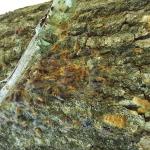 Gypsy Moth: Since our last landscape message, gypsy moth adult activity has come to an end in most areas, particularly inland locations in Massachusetts. The Massachusetts Department of Conservation and Recreation (DCR) has aerially mapped defoliation in the state for 2016. Their map includes 352,774 acres of defoliation they have attributed to gypsy moth this year. To view this map and the locations hit hardest by the feeding caterpillars, visit:
Gypsy Moth: Since our last landscape message, gypsy moth adult activity has come to an end in most areas, particularly inland locations in Massachusetts. The Massachusetts Department of Conservation and Recreation (DCR) has aerially mapped defoliation in the state for 2016. Their map includes 352,774 acres of defoliation they have attributed to gypsy moth this year. To view this map and the locations hit hardest by the feeding caterpillars, visit:  2016 Aerial Gypsy Moth Survey
2016 Aerial Gypsy Moth Survey
If many egg masses were laid in your area by the adult females, it may not be a bad idea to start planning which management options you are going to choose for next spring. These options can include hoping for a wet spring, so that Entomophaga maimaiga, the insect killing fungus, will become more active earlier in gypsy moth and reduce the population next year. They can also include using Bacillus thuringiensis Kurstaki on the young caterpillars when they first hatch from their eggs next year around 90 GDD’s, base 50°F. Be advised that while this may lead to the demise of young caterpillars feeding on the host trees to which it is applied, it is not a guarantee that caterpillars “ballooning in” (using silk strands to catch air currents to disperse) from wooded areas won’t do any damage. Older caterpillars can be managed using spinosad, however treating gypsy moth early, when caterpillars are still small, is best.
For now, inventory the number of egg masses that have been laid. If multitudes of egg masses are present on property you wish to manage, you may consider such applications next season. Traps are for monitoring purposes only and do not effectively reduce adult populations.
 Entomophaga maimaiga has been observed in the cadavers of caterpillars. The spores of this fungus will be present next season. Environmental factors such as rainfall amounts next spring (which impact Entomophaga spread and infection in these caterpillars) can make predicting caterpillar activity for next season difficult. Rain next spring may determine whether or not we have another year of extensive defoliation. While it is possible that we could have a wet spring and the fungus could become active enough (early enough) in the gypsy moth population, there are certainly plenty of egg masses out in the environment at this time, out of which many caterpillars could hatch next season.
Entomophaga maimaiga has been observed in the cadavers of caterpillars. The spores of this fungus will be present next season. Environmental factors such as rainfall amounts next spring (which impact Entomophaga spread and infection in these caterpillars) can make predicting caterpillar activity for next season difficult. Rain next spring may determine whether or not we have another year of extensive defoliation. While it is possible that we could have a wet spring and the fungus could become active enough (early enough) in the gypsy moth population, there are certainly plenty of egg masses out in the environment at this time, out of which many caterpillars could hatch next season.
For more information about gypsy moth this year, please visit: https://ag.umass.edu/news-events/highlights/gypsy-moth-outbreak-in-massachusetts-2016.- Andromeda Lacebug: Stephanitis takeyairemains active on Japanese Andromeda and will continue into September. Inspect plants known to have S. takeyai in the past (or exhibiting yellow stippling on the upper leaf surface) and inspect undersides of leaves for this season’s lacebugs. Before populations become too large, treat with a summer rate horticultural oil spray as needed. Be sure to target the undersides of the foliage in order to get proper coverage of the insects.
- Azalea Lacebug: Stephanitis pyrioidesis active on evergreen azaleas. This insect may be more damaging on plants located in warm, sunny locations. Like andromeda lacebug, this insect will remain active into the fall. Plants in hot, dry, sunny sites may be severely impacted by mid- August. Horticultural oil sprays targeting the undersides of the foliage can be very effective for this pest.
- Black Vine Weevil: Otiorhynchus sulcatus damage is apparent on rhododendron and taxus, but can also be seen on azalea, mountain laurel, and Euonymus. Adult weevils feed along the leaf/needle margins and create rounded notches. Inspect foliage of these plants for notching as adults are feeding. Burlap laid around the base of plants during the time adults are active, now through August, can be inspected weekly for adult weevils which can be killed before egg laying.
- Dogwood Borer: Synanthedon scitula. Flowering dogwoods (and others) exhibiting dieback beginning in the crown and working its way downward may be attacked by this pest. Inspect trunk and large branches for holes and sawdust. Destroy by hand.
- Hemlock Woolly Adelgid: Adelges tsugae is present on eastern and Carolina hemlock and is in its summer dormant period which will last until approximately mid-October. Dormant nymphs can be treated throughout the summer with a horticultural oil spray at the summer rate, however be careful to follow all label instructions to avoid injury to the plant, especially with the current hot weather.
- Rhododendron Borer: Synanthedon rhododendri. Inspect the base of shoots, old pruning sites, and branch crotches for sawdust, which may indicate the presence of this pest. Destroy by hand.
- Taxus Mealybug: Dysmicoccus wistariae remain active. Inspect the inner branches of yew (Taxus) for the white, soft-bodied insects. Honeydew and sooty mold may also be present. When present in large numbers, plants may become stunted and unsightly. If needed, treat the inner branches with a horticultural oil spray at the summer rate.
- Two-Spotted Spider Mite: Tetranychus urticae is active and is a “warm-season” mite that loves hot and dry weather which may favor the quick reproduction and build-up of this pest. Management should seek to preserve beneficial predatory mites. Monitor susceptible hosts (such as many deciduous species) for increasing numbers of these mites until mid-August. Mites will be found on the undersides of leaves and cause stippling of the foliage.
- Viburnum Leaf Beetle: Adults have been actively feeding and will continue into September. Adult beetles may be targeted with a pyrethroid; however, adult beetles are generally more difficult to manage than the larval stages. Planting species of viburnum that are most resistant to the viburnum leaf beetle can help manage this pest. Resistant varieties include V. bodnantense (dawn viburnum), V. carlesii (Koreanspice viburnum), V. davidii (David viburnum), V. sieboldii (Siebold viburnum), and others. Highly susceptible species of viburnum frequently attacked by this beetle can include V. dentatum (arrowwood viburnums), V. opulus (European cranberrybush viburnum), and V. rafinesquianum (Rafinesque viburnum).
Concerned that you may have found an invasive insect or suspicious damage caused by one? Need to report a pest sighting? If so, please visit the Massachusetts Introduced Pests Outreach Project: http://massnrc.org/pests/pestreports.htm.
A note about Deer Tick Awareness: deer ticks (Ixodes scapularis), the American dog tick (Dermacentor variabilis), and the lone star tick (Amblyomma americanum) are all found throughout Massachusetts. Each can carry their own complement of diseases. Adults and nymphs are active and anyone working in tick habitats (wood-line areas, forested areas, and landscaped areas with ground cover) should check themselves regularly for ticks while practicing preventative measures. Have a tick and need it tested? Visit the web page of the Laboratory of Medical Zoology (www.tickdiseases.org) and click on the red Test a Tick button for more information.
Report by Tawny Simisky, Extension Entomologist, UMass Extension Landscape, Nursery, & Urban Forestry Program
Management Practices
Plant Drought Stress Symptoms
With much of Massachusetts now either under a severe or moderate drought according to the U.S. Drought Monitor (http://droughtmonitor.unl.edu/Home/StateDroughtMonitor.aspx?MA) even established plants are showing stress symptoms. Plants’ ability to and method of dealing with drought stress can vary by species or even cultivar. Drought stress symptoms can include: wilting, stunted or slowed growth, dull leaf color, yellowing leaves, scorched leaves, rolled or curled leaves, early fall color, and leaf drop.
Some water stress symptoms are mechanisms plants use to deal with drought stress, and include leaf movements including wilting, rolling, reorientation from a horizontal to a vertical orientation, or abscission (leaf drop). The main purpose of most of these mechanisms is to reduce the amount of leaf surface area which in turn reduces that amount of light and heat absorbed by the plant and the amount of water lost to cooling via transpiration. Leaf rolling also reduces air movement around the leaf surface, and creates a high relative humidity microclimate within the roll; both of which contribute to reduced transpiration. It is important to keep in mind that some plants may drop all of their leaves and appear dead, but may still be alive. Water stressed plants are also more susceptible to insects and pathogens.
Remember that less frequent deep watering is more effective than frequent shallow watering in helping plants deal with water stress. Efficient irrigation application methods such as soaker hoses and drip irrigation are best for ensuring water reaches the root zone of the plant.
Plant of the Week: Hibiscus syriacus
Hibiscus syriacus is a large, upright, multi-stemmed shrub growing 8-12’ tall and 6-10’ wide. Plants flower from July through September. Flowers have 5 petals, are 2-4” wide, and can be single or double, white, pink, purple, violet, or a combination depending on cultivar. Flowers are formed on the current season’s growth. Leaves are late to emerge in spring and are medium to dark green and 3 lobed. Can grow in full sun to part shade with best flowering in full sun. Plants are tolerant of poor soil and some drought, heat and humidity, and urban conditions. Rose of Sharon, or althea, is best used as a late season blooming shrub for shrub borders or mass groupings. Insect and diseases are not normally a problem but plants can be susceptible to Japanese beetle, leaf spots, blight, canker, rust, and whitefly.
Report by Mandy Bayer, Extension Assistant Professor, UMass Stockbridge School of Agriculture
Additional Resources
To receive immediate notification when the next Landscape Message update is posted, be sure to join our e-mail list and follow us on Facebook and Twitter.
For a complete listing of upcoming events, see our Upcoming Educational Events page.
For commercial growers of greenhouse crops and flowers - Check out the New England Greenhouse Update website
For professional turf managers - Check out Turf Management Updates
For home gardeners and garden retailers - Check out home lawn and garden resources. UMass Extension also has a Twitter feed that provides timely, daily gardening tips, sunrise and sunset times to home gardeners, see https://twitter.com/UMassGardenClip
Diagnostic Services
A UMass Laboratory Diagnoses Landscape and Turf Problems - The UMass Extension Plant Diagnostic Lab is available to serve commercial landscape contractors, turf managers, arborists, nurseries and other green industry professionals. It provides woody plant and turf disease analysis, woody plant and turf insect identification, turfgrass identification, weed identification, and offers a report of pest management strategies that are research based, economically sound and environmentally appropriate for the situation. Accurate diagnosis for a turf or landscape problem can often eliminate or reduce the need for pesticide use. For sampling procedures, detailed submission instructions and a list of fees, see Plant Diagnostics Laboratory
Soil and Plant Nutrient Testing - The University of Massachusetts Soil and Plant Nutrient Testing Laboratory is located on the campus of The University of Massachusetts at Amherst. Testing services are available to all. The function of the Soil and Plant Nutrient Testing Laboratory is to provide test results and recommendations that lead to the wise and economical use of soils and soil amendments. For complete information, visit the UMass Soil and Plant Nutrient Testing Laboratory web site. Alternatively, call the lab at (413) 545-2311.
Ticks are active at this time! Remember to take appropriate precautions when working and playing outdoors, and conduct daily tick checks. UMass tests ticks for the presence of Lyme disease and other disease pathogens. Learn more
